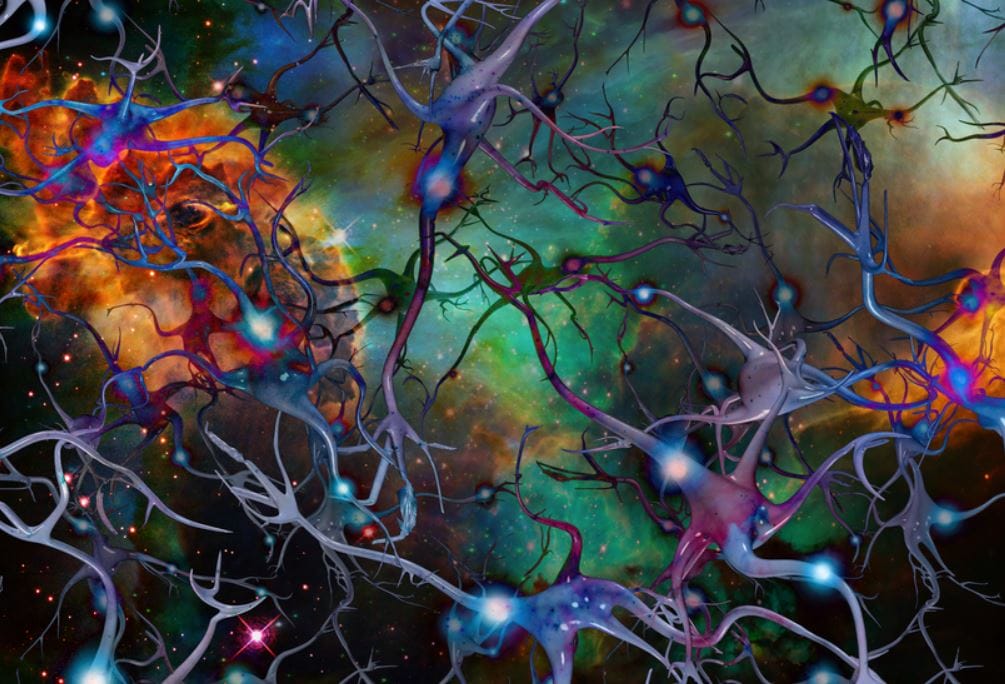Cytamins – powerful bioregulators of cellular metabolism
December 13, 2021
As you know, proteins are the building material of any living organism. The receipt of proteins by the brain cells is necessary for normal brain function. Proteins consist of various amino acids. Peptides are “small proteins” of two or more amino acids linked in a chain.
There are peptides of animal origin (Cerebrolysin, Cortexin, Thymalin) and chemically synthesized ones (Semax, Selank, Thymogen, Noopept, Demoxytocin, Deltaran).
There is also another group of peptides called oral peptide-bioregulators. This group falls into three major branches:
In this blog post, we will look at the Cytamins category in more detail and share some interesting facts from the book “Cytamins – bioregulators of cellular metabolism” by Dr. Morozov (Ph.D.), Dr. Ryzhak (Ph.D.) et al [1].
Table of Contents:
- What are Cytamins?
- Cytamins Research
- How are Cytamins Produced?
- What are the Effects of Cytamins?
- Cerebramin® for Brain Function
- About the Authors
- Bibliography
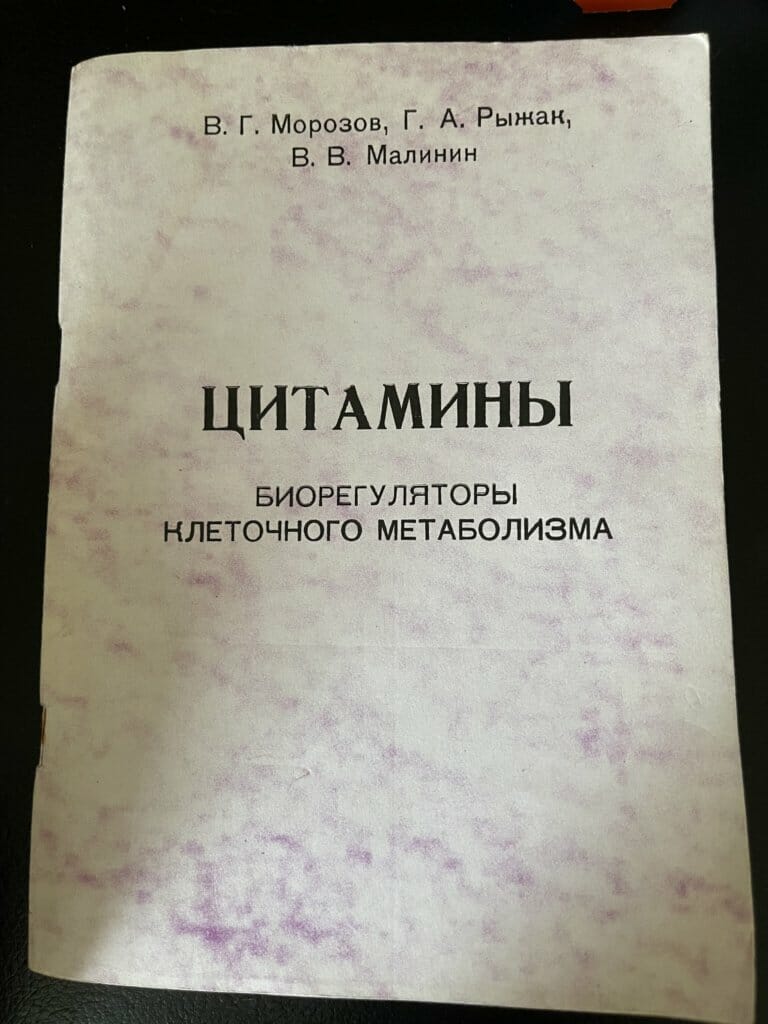
What are Cytamins?
Cytamins are oral peptide bio-regulators of natural origin, which normalize and support the activity of human organs and systems, increase the body’s resistance to the effects of adverse factors, and help maintain health, beauty, and activity for many years. They are supplements devoid of side effects and used mostly for longevity purposes.
The components for these products are obtained through the process of purification of different respective organs of cattle and are essentially a complex of various proteins and nucleoproteins. To read more about the process of cytamins production go to this section.
These products are not expensive and can be bought in Russian pharmacies OTC. Geropharm which produces Cytamins is a very reputable Russian manufacturer that also makes Cortexin mentioned above.
An important advantage of Cytamins is that they are natural in origin. For that reason, their action is physiological for the body. Cytamins are said to have no side effects because animal peptides are identical to human ones. Besides, they go through purification stages while processing. [3] Cytamins are compatible with other supplements and medications including hormonal ones. They are often used in the complex therapy of various diseases. [4]
The Book on Cytamins with Research
Cytamins were developed in the Saint-Petersburg Institute of Bioregulation and Gerontology by a team of researchers including the authors of the book.
The science of aging is developing rapidly. Problems of prevention of cardiovascular, oncological, and other “age-related” diseases remain relevant. The efforts of scientists are aimed at understanding the causes of aging and finding effective means to slow down this process. One of the tasks is to prolong the active period of life.
After many years of scientific and clinical research (1971-1999), the authors of the book have developed a method for the comprehensive prevention of age-related pathology, slowing down the aging process, and increasing life expectancy. Bioregulatory therapy is a new theoretically substantiated direction of experimental and clinical medicine that is associated with the study of molecular and cellular mechanisms that control homeostasis, and the development of means and methods for restoring physiological functions of the body in order to prevent and treat diseases.
The modern view on the role of informational peptide molecules in regulation processes at the para- and autocrine level served as the basis for the creation of a new class of drugs – peptide bioregulators.
First peptide bioregulators of multicellular systems were isolated by V.V. Morozov and V.Kh. Khavinson in 1971 from the hypothalamic region of the brain, pineal gland, thymus, and vascular wall (patent No.934589). It turned out that they all have immunomodulatory, anticoagulant, and antitumor effects. [2] To date, peptides similar in nature and physicochemical properties, but differing in functional activity, have been isolated from almost all organs, cells, and tissues of the body.
Their regulatory effects are based on their ability to induce the processes of specific differentiation of specialized cell populations, and, therefore, to regulate their number and functional activity in normal conditions and in pathological processes. This made it possible to consider these drugs as potential axenobiotic agents, devoid of side effects, which is due to their physiological homeostatic effect on the human body.
These preparations belong to the group of parapharmaceuticals – pharmacologically active substances that have a regulatory effect on various functional systems of the body within the normal range.
Cytamins are interpolymeric complexes of tissue-specific proteins with RNA and DNA. The connection between the components in these complexes is determined by the system of electrostatic interactions between the charged side groups of proteins and nucleic acids. Therefore, the stability of nucleoprotein complexes and the native structure of their components depend on the pH of the solution and the concentration of the electrolyte (ionic strength).
Based on the studies, it can be concluded that nucleoprotein complexes include histones of all classes – H2A, H2B, H3, H4, and H1 with molecular weights of 14-22 kDa, as well as acidic proteins – chalones with molecular weights of 56-70 kDa. This allows the obtained substances to be attributed to the nuclear material of the cell. As X-ray diffraction studies show, these exact nucleoprotein complexes exist in the chromatin of a normal (healthy) differentiated cell, and the DNA components of these complexes are homologous to the damaged DNA of a certain tissue of the human body because they are isolated from the same but healthy mammalian tissue. [1]
How are Cytamins Produced?
The technology for the isolation of nucleoprotein complexes is protected by the patent of the Russian Federation. The method for isolating nucleoprotein complexes is based on alkaline hydrolysis and partial enzymatic destruction of cell and nuclear membranes. In this case, the contents of the cell nucleus, along with cytoplasmic proteins, pass into a solution form, where the integrity and native structure of nucleosomes are maintained with the help of magnesium ions. The technological process also includes the precipitation of the isolated nucleoprotein complexes in an acetic acid solution and the subsequent multistage purification of the complexes from ballast substances. The resulting semi-finished products are dried under a vacuum and used for the production of ready-made forms of cytamins. Production technology stages are adjusted for each type of tissue.
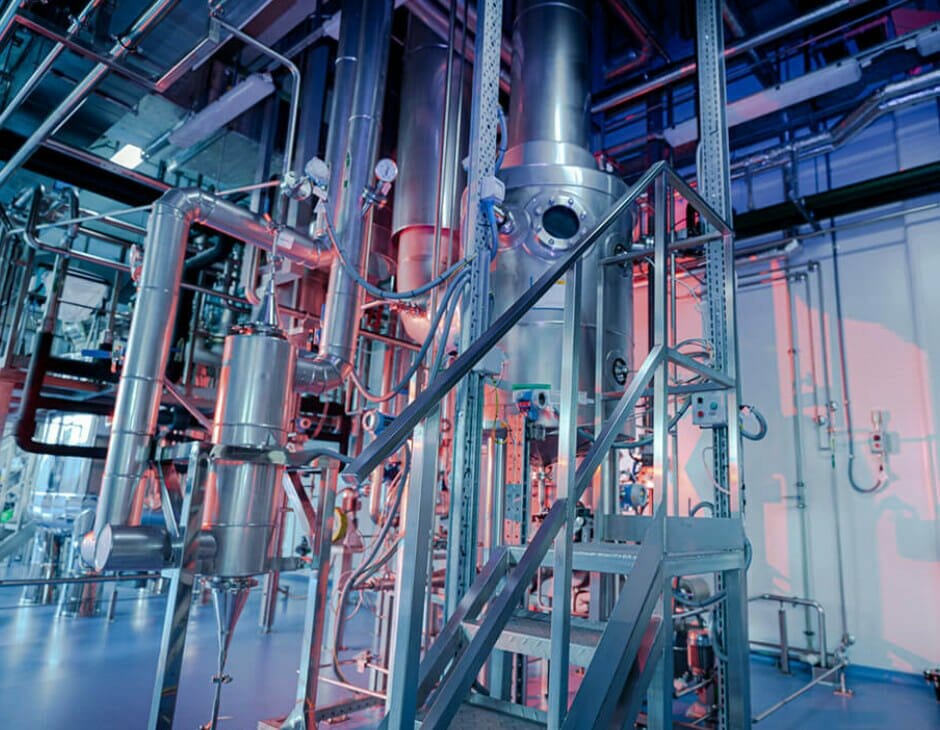
Within the patented technology Cytamins are produced in the form of tablets or capsules with an enteric coating. It prevents the destruction of the active components by enzymes of gastric juice.
It should be emphasized that Cytamins are natural in origin: there is no inclusion of any additional components or preservatives in the composition of natural raw materials. The chemical composition of Cytamins for example Cerebramin which is given below demonstrates the chemical composition of the tissue from which the nucleoprotein complexes were isolated.
What are the Effects of Cytamins? [3]

The effect of Cytamin bioregulators is manifested at all stages of cellular metabolism – from the transport of nutrients through the cell membrane to the excretion of intracellular metabolic products. Unlike many other parapharmaceuticals, they:
- do not have a stimulating or depressing effect on the processes of cellular metabolism,
- contain proteins and fats,
- almost do not contain carbohydrates,
- are a low-calorie product, which, among other things, allows them to be used in dietetic nutrition.
The main mechanism of the biological action of Cytamins is that they correct cellular metabolism in damaged cells of the tissue from which they are isolated. On the one hand, they prepare immature cells of the original tissue for normal development into mature forms, and on the other hand, they correct cell metabolism in normally developed cells of a particular tissue.
As a result, the target tissue produces morphologically normal cells with an optimal level of cellular metabolism. This process is physiological in nature: due to the optimization of cellular metabolism when taking Cytamins, the need for exogenous proteins in cells decreases, the body’s resistance to the effects of various pathogenic factors increases, and immunity normalizes.
Thus, the lifespan increases and the functional activity of cell populations and the organism as a whole is restored.
Adding Cytamins to medical diet might be useful in case you want to:
- Provide protection and normal functioning of tissues and organs;
- Ensure high performance in case of elevated loads (including sports);
- Prevent diseases;
- Accelerate rehabilitation after an illness, injury, or operation;
- Enhance body resistance when exposed to adverse factors: climate, occupational, stress.
Cerebramin® – a cytamin that regulates brain function
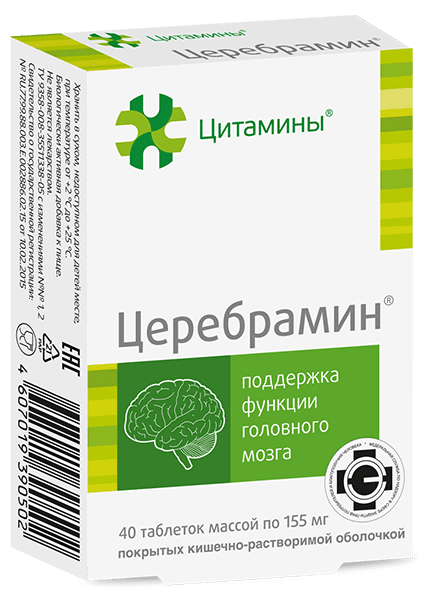
Cerebramin is isolated from the cerebral cortex of animals. It is a nucleoprotein complex that has a selective effect on brain cells, helping to accelerate the recovery of brain functions. According to the producer, Cerebramin helps to normalize the function of the brain, and improve memory and attention. It is recommended for intense mental activity. [3]
Composition of Cerebramin [3]
Nutrients, %
| Proteins | 59.3 |
| Fats | 14.9 |
| Carbon | 6.4 |
| Ash | 7.2 |
| Moisture | 12.2 |
| Caloric value, kcal/100 g | 369.9 |
Vitamins, mg/kg
| Thiamine (B1) | 3.61 |
| Riboflavin (B2) | 1.86 |
| Niacin (PP) | 1.0 |
| Retinol (А) | 0.01 |
| Tocopherol (E) | 0.32 |
Minerals, mg/g
| Aluminum | 0.012 |
| Cobalt | < 0.00034 |
| Copper | 0.021 |
| Iron | 0.11 |
| Magnesium | 1.8 |
| Calcium | 0.13 |
| Calcium | 0.97 |
| Sodium | 26.0 |
| Manganese | 0.00017 |
| Molybdenum | 0.00018 |
| Phosphorus | 5.4 |
| Sulfur | 9.9 |
| Zinc | 4.74 |
| Lead | 0 |
| Cadmium | < 0.002 |
Amino Acids, nmol/gm
| Asparagic acid | 436 |
| Threonine | 221 |
| Serine | 256 |
| Glutamic acid | 646 |
| Proline | 354 |
| Glycine | 49 |
| Alanine | 380 |
| Valine | 277 |
| Methionine | 96 |
| Isoleucine | 269 |
| Leucine | 372 |
| Tyrosine | 144 |
| Phenylalanine | 202 |
| Histidine | 118 |
| Lysine | 271 |
| Arginine | 186 |
The book on Cytamins describes one of the clinical trials of Cerebramin. Tests were carried out in 257 patients with various diseases of the central nervous system, long-term consequences of TBI (the duration of the injuries from 1 to 10 years), conditions after a stroke, vascular encephalopathies, decreased mental performance, memory, and attention. A special group consisted of patients with intellectual-mnestic disorders due to neuro infection (neuroborreliosis), demyelinating diseases (multiple sclerosis and multiple encephalomyelitides), and cerebral atherosclerosis. The control groups consisted of 188 similar patients who received conventional treatment. [1]
Study Results
After the use of Cerebramin in patients of all studied groups, a good clinical result was observed in 69.4% of cases, satisfactory – 21.9%, no positive effect – 8.7%. A negative effect of Cerebramin on the condition of patients was not recorded.
When comparing the subjective indicators of the state of patients before and after the use of Cerebramin, it was found that the number of health complaints decreased by 2-3 times. Patients noted an improvement in memory, intelligence, a decrease in the intensity and duration of headaches, increased emotional balance, volitional qualities, and a sense of rest after a night’s sleep. (see Table 11) In patients with the consequences of TBI and stroke, there was a regression of focal symptoms, an improvement in speech function with motor and sensory aphasia, and a decrease in muscle spasticity. [1]
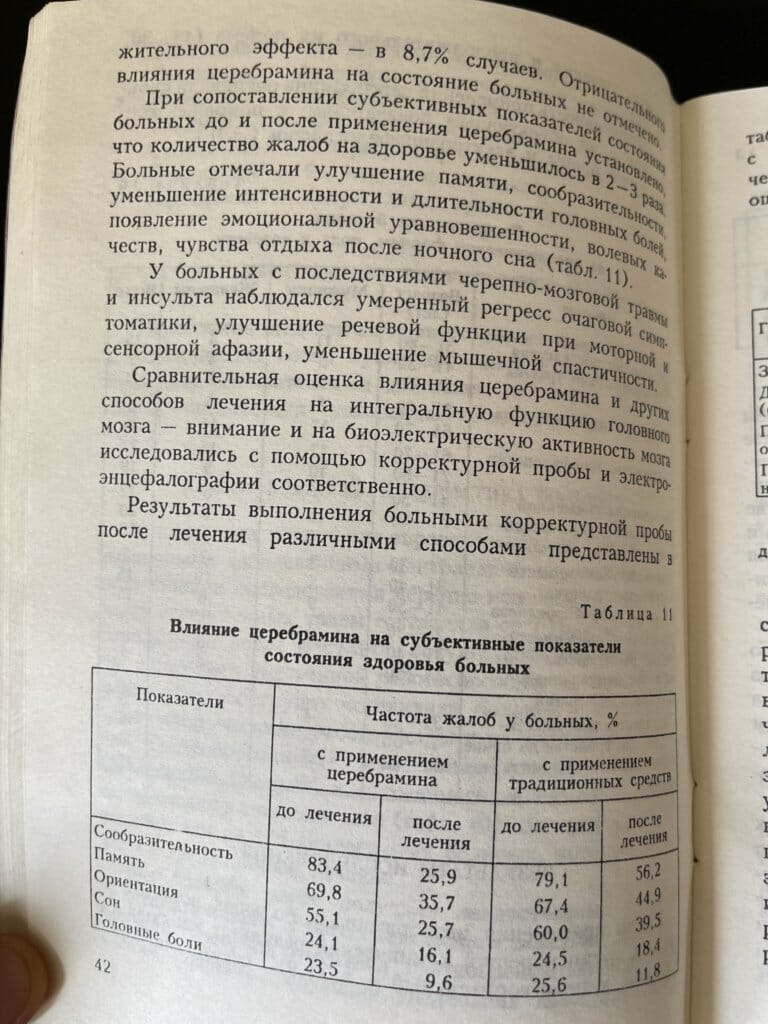
The results of the clinical study of Cerebramin demonstrate its efficacy in the complex treatment and prevention of CNS diseases of various genesis. The supplement does not have side effects and does not cause withdrawal.
The recommended dosage is 1-3 tablets 10-15 min before meals, 2-3 times a day for 10-15 days. The course can be repeated after 3-6 months.
About the Authors of the Book on Cytamins
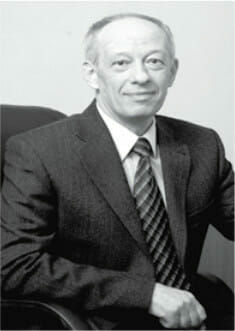
Vyacheslav G. Morozov, Ph.D., was the Deputy Head of the Saint Petersburg Institute of Bioregulation and Gerontology. V.G. Morozov made a great contribution to the development of Soviet and Russian medicine. He was one of the pioneers of the development of new methods of immunodiagnostics and immunotherapy in the medical service of the Armed Forces of the USSR. He created the theory of peptide regulation of cellular systems and body functions. The works of V.G. Morozov made it possible to theoretically substantiate a new direction in medicine – bioregulatory therapy, and for the first time develop and master an industrial technology for obtaining peptide drugs. V.G. Morozov was the author of over 500 scientific papers and domestic and foreign patents.
V.G. Morozov was awarded 10 medals by the USSR and 4 medals in the Exhibition of Economic Achievements of the USSR for impeccable service in the Armed Forces and for the development and introduction of new highly efficient peptide bioregulators into industrial production and health care. In 1998 he was awarded a Diploma and a commemorative medal “Author of Scientific Discovery” by the Russian Academy of Natural Sciences. V.G. Morozov was a member of a number of Russian and international scientific societies, including the International Cytokine Society and the International Society for the Biology of Leukocytes.

Galina A. Ryzhak, Ph.D., Deputy R&D Director of the Saint Petersburg Institute of Bioregulation and Gerontology, North-West Branch of the Russian Academy of Medical Sciences, Professor, Doctor of Medical Sciences.
G.A. Ryzhak is a scientific specialist in the field of experimental and clinical study of peptide geroprotective agents. The main direction of her professional activity is the study of the mechanisms of aging and the development of methods for the prevention and correction of age-related pathology, based on the pathogenetic use of peptide bioregulators. Galina Ryzhak took part in the development of technology and organization of production of 35 pharmaceuticals and biologically active supplements approved by the Ministry of Health of the Russian Federation for medical use. She is the author of over 180 scientific publications, including 5 monographs and 10 guidelines. She is the author of 49 patents in the field of biotechnology and pharmacology.
Bibliography
- Morozov VG, GA Ryzhak et al (1999). Cytamins-bioregulators of cellular metabolism. https://search-rsl-ru.translate.goog/ru/record/01000638186?_x_tr_sl=ru&_x_tr_tl=en&_x_tr_hl=ru
- Khavinson V.Kh. (2002). Peptides and aging. https://khavinson.info/publications
- https://cytamins.ru/
- Tsygan VN, Shangin AB et al (2009). Cytamins – modern preparations with organotropic action. https://xn--c1atere.xn--p1ai/upload/files/cytamins_2009.pdf


